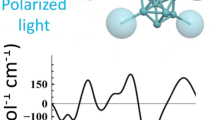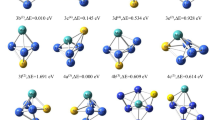Abstract
We report results of hyperpolarizability calculations on CdnXn (X: S, Se and Te; n = 1–10) clusters. Our results show that the geometric configurations of different types of clusters under investigation are quite similar at specific values of n. Both static and frequency dependent components of first and second order hyperpolarizability tensors of CdnSn, CdnSen and CdnTen are compared. It is observed that in general nonlinear optical coefficients show identical variation in all the cluster materials. The present investigation also manifests the improvement of these coefficients due to the introduction of asymptotically correct generalized gradient approximation functional over the local density functional and normal gradient corrected functional. Symmetrized fragment orbital analysis has been performed to provide explanation of the observed hyperpolarizability variation. We also analyse how geometries with closely lying energy values influence the hyperpolarizabilities of these cluster materials.














Similar content being viewed by others
References
K. D. Bonin and V. V. Kresin, Electric dipole polarizabilities of atoms, molecules and clusters (World Scientific, Singapore, 1997).
M. Lee, E. H. Katz, C. Erben, D. M. Gill, P. Gopalan, J. D. Heber, and D. J. McGee (2002). Science 298, 1401.
Y. Shi, C. Zhang, H. Zhang, J. H. Bechtel, L. R. Dalton, B. H. Robinson, and W. H. Steier (2000). Science 288, 119.
J. Luo, M. Haller, H. Li, H. -Z. Tang, A. K. -Y. Jen, K. Jakka, C. -H. Chou, and C. -F. Shu (2004). Macromolecules 37, 248.
C. Zhang, L. R. Dalton, M. C. Oh, H. Zhang, and W. H. Steier (2001). Chem. Mater. 13, 3043.
W. L. Peticolas (1967). Annu. Rev. Phys. Chem. 18, 233.
W. Denk, J. H. Stricker, and W. W. Webb (1990). Science 248, 73.
C. W. Spangler (1999). J. Mater. Chem. 9, 2013.
K. R. S. Chandrakumar, T. K. Ghanty, and S. K. Ghosh (2005). Int. J. Quant. Chem. 105, 166.
G. Maroulis and C. Pouchan (2003). J. Phys. Chem. B 107, 10683.
B. S. Santos, G. A. L. Pereira, D. V. Petrov, and C. de Mello Donegá (2000). Optics. Commun. 178, 187.
M. C. Troparevsky and J. R. Chelikowsky (2001). J. Chem. Phys. 114, 943.
G. Maroulis and C. Pouchan (2008). Chem. Phys. Lett. 464, 16.
M. Jacobsohn and U. Banin (2000). J. Phys. Chem. B 104, 1.
O. A. Aktsipetrov, P. V. Elyutin, A. A. Nikulin, and E. A. Ostrovskaya (1995). Phys. Rev. B 51, 17591.
P. Karamanis, G. Maroulis, and C. Pouchan (2006). J. Chem. Phys. 124, 071101.
P. Karamanis, G. Maroulis, and C. Pouchan (2006). Chem. Phys. 331, 19.
S. Sen and S. Chakrabarti (2006). Phys. Rev. B 74, 205435.
P. C. Jha, P. Seal, S. Sen, H. Ågren, and S. Chakrabarti (2008). Comp. Mater. Sci. 44, 728.
M. C. Troparevsky, L. Kronik, and J. R. Chelikowsky (2003). J. Chem. Phys. 119, 2284.
S. Bhattacharya and A. Kshirsagar (2007). Phys. Rev. B 75, 035402.
S. Mayilo, J. Hilhorst, A. S. Susha, C. Höhl, T. Franzl, T. A. Klar, A. L. Rogach, and J. Feldmann (2008). J. Phys. Chem. C 112, 14589.
J. Sun, W. E. Buhro, L.-W. Wang, and J. Schrier (2008). Nano Lett. 8, 2913.
P. Dagtepe, V. Chikan, J. Jasinski, and V. J. Leppert (2007). J. Phys. Chem. C 111, 14977.
P. Karamanis and C. Pouchan (2009). Chem. Phys. Lett. 474, 162.
P. Seal, S. Sen, and S. Chakrabarti (2010). Chem. Phys. 367, 152.
M. J. Frisch et al., GAUSSIAN 03 (Gaussian Inc., Walingford, CT, 2004).
A. D. Becke (1993). J. Chem. Phys. 98, 1372.
C. Lee, W. Yang, and R. G. Parr (1988). Phys. Rev. B 37, 785.
R. van Leeuwen and E. J. Baerends (1994). Phys. Rev. A 49, 2421.
A. D. Becke (1988). Phys. Rev. A 38, 3098.
J. P. Perdew, K. Burke, and M. Emzerhof (1996). Phys. Rev. Lett. 77, 3865.
S. J. A. van Gisbergen, J. G. Snijders, and E. J. Baerends (1998). J. Chem. Phys. 109, 10644.
S. J. A. van Gisbergen, J. G. Snijders, and E. J. Baerends (1998). J. Chem. Phys. 109, 10657.
S. Sen, P. Seal, and S. Chakrabarti (2007). Phys. Rev. B 76, 115414.
P. Deglmann, R. Ahlrichs, and K. Tsereteli (2002). J. Chem. Phys. 116, 1585.
S. M. Ma, J. T. Seo, Q. Yang, R. Battle, L. Creekmore, K. Lee, B. Tabibi, and W. Yu (2007). Appl. Surf. Sci. 253, 6612.
P. Chin, J. Stouwdam, S. van Bavel, and R. Janssen (2008). Nanotechnology 19, 205602.
Acknowledgments
S. C. acknowledges the financial support (UPE project) for providing us the 8 CPU clusters. S. Sen acknowledges Prof. A. Guha, Director, JIS College of Engineering. P. Seal likes to thank UGC, Govt. of India for the financial assistance. The authors acknowledge the financial support from DST, Govt. of India (Under FIST Program) to purchase the Gaussian 03 program. The financial support from UGC, Govt. of India (Xth plan) to purchase the ADF program is gratefully acknowledged.
Author information
Authors and Affiliations
Corresponding author
Electronic supplementary material
Below is the link to the electronic supplementary material.
10876_2010_337_MOESM1_ESM.pdf
Average values of the static and frequency dependent first and second order hyperpolarizability tensors at different levels of theory and the optimized energies of all CdnXn clusters (n = 1–10). (PDF 771 kb)
Rights and permissions
About this article
Cite this article
Sen, S., Seal, P. & Chakrabarti, S. A Comparative Study of the Nonlinear Optical Properties of CdnXn (X: S, Se and Te) Clusters. J Clust Sci 21, 591–609 (2010). https://doi.org/10.1007/s10876-010-0337-3
Received:
Published:
Issue Date:
DOI: https://doi.org/10.1007/s10876-010-0337-3




